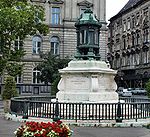Royal Curia of Hungary
Courts and tribunals disestablished in 1949Courts and tribunals established in 1723Former supreme courtsHungary under Habsburg ruleKingdom of Hungary (1920–1946)

The Royal Curia of Hungary (Hungarian: Magyar Királyi Kúria, Latin: Curia Regia) was the supreme court of the Kingdom of Hungary (Hungary and Croatia) between 1723 and 1949. Charles VI in 1723 divided it into two courts: the Tabula Septemviralis (Court of the Seven) and the Tabula Regia Iudiciaria (Royal Court). The Tabula Regia functioned under a dignitary named the Personalis, in the case of prevention, of the elder Baron Court.
Excerpt from the Wikipedia article Royal Curia of Hungary (License: CC BY-SA 3.0, Authors, Images).Royal Curia of Hungary
Kossuth Lajos Square, Budapest Lipótváros
Geographical coordinates (GPS) Address Nearby Places Show on map
Geographical coordinates (GPS)
| Latitude | Longitude |
|---|---|
| N 47.507813888889 ° | E 19.048419444444 ° |
Address
Igazságügyi palota
Kossuth Lajos Square 12
1055 Budapest, Lipótváros
Hungary
Open on Google Maps










